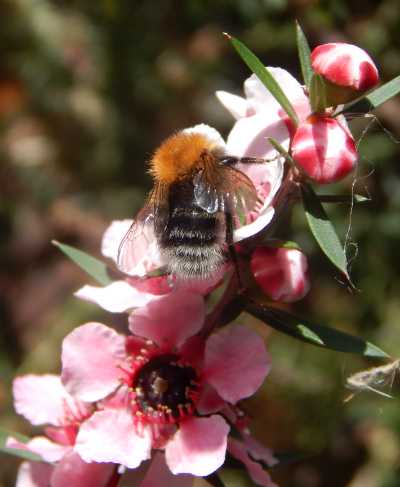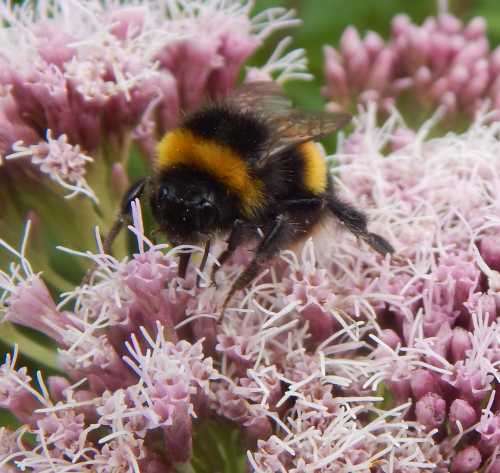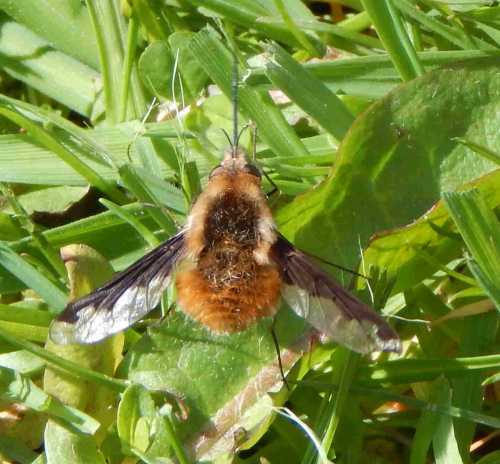Have you found dead bumble bees with missing head or abdomen?
You may have discovered dead bumble bees beneath a tree or nest site, and think it very strange that the heads are missing, or perhaps the bodies have been pecked at in some way; and you are wondering what has caused this.
I received such a query:
“I have a Bombus hypnorum (Tree bumble bee) nest in my blue tit bird box. I’m really thrilled, as I have been watching lots of bumble bees flying around the nest entrance.
But the other day I noticed dead headless bumble bees on the ground. How has this happened, and what has decapitated the bumble bees?”
What is the cause of decapitated bumble bees?
This phenomenon tends to occur where there are many bumble bees - and probably feeding,
so for example, decapitated or abdomen-less bumble bees may be found beneath a
flowering tree or shrub where they have been foraging.
However, in this case, a Bombus hypnorum ‘drone cloud’ was the target (males of this species fly around the nest entrance waiting for new queens to emerge so they can pounce on the queens and mate. The males cannot sting).
 Above: Bombus hypnorum - the Tree Bumble Bee
Above: Bombus hypnorum - the Tree Bumble BeeHeadless bees are a sign of bird predation – notably by great tits,
who may attack the bumble bees, taking apparently the head or abdomen.
This behaviour is described by Professor Dave Goulson in his book A Sting in the Tale: My Adventures with Bumblebees.
From pages 128 – 129, Goulson writes of naturalists sharing records and observations of dead bumble bees with missing heads and abdomens:
"One morning when having breakfast on the lawn, Anne-Marie noticed many dead bumblebees under the trees. On closer inspection she found that each had been attacked in the same way - the back of the head had been opened up, and the brain scooped out.
The abdomen had also been opened and hollowed out. Intrigued and slightly horrified, Anne-Marie and Chris set out to discover the culprit by hiding themselves out of sight and watching the tree with binoculars.
They didn't have to wait more than a few minutes. A whole family of great tits emerged, a pair of adults with their young, and they continued their banquet.
Being apparently drunk on the lime nectar, the bees were easy prey to the birds, which had presumably learned how to avoid the stings and peck open the bees' bodies."
Goulson goes on to state that he received further records of
headless bumble bees, nipped off abdomens, or opened up thorax:
"In particular places, the birds seem to have developed different techniques. Some birds seem to open up the thorax, others nip off the tip of the abdomen, still others go for the head, or different combinations of the three."
Similarly, Ted Benton in his excellent and very
comprehensive book Bumblebees (Collins New Naturalist), also mentions similar examples of bird
predation when describing potential predators of Bombus lucorum (white tailed
bumblebee); Bombus terrestris (buff tailed bumblebee); Bombus lapidarius
(red-tailed bumblebee):
Pg 321:
“There is also a report of predation on queens by
great tits, which were probably collecting them from cracks in the bark of a
tree where they were spending the nights after hibernation.
Later in the year they are among the species
whose eviscerated carcasses can be found in considerable numbers under trees –
presumably victims of predation by birds (probably great or blue tits)”.
Pg 327:
“Eviscerated bodies of B. terrestris workers are among those frequently found under lime trees in early summer, presumably the victims of predation by birds (probably blue or great tits).”
Pg 365:
“Also, workers of this species are among those whose eviscerated bodies can
often be found under trees - presumably the victims of predation by birds probably
blue or great tits.”
What should I do about it?
Nothing. This is natural predation. Allow nature to takes its course.
Ever wondered......
Do bumble bees make honey?

If you found this page helpful or interesting, I'd really be grateful if you would share it with others - if not this page, perhaps another, such as Gardening For Bees.
Thank you so much :) .
